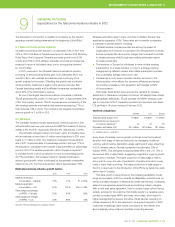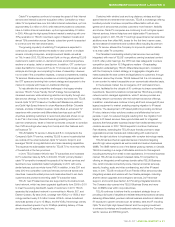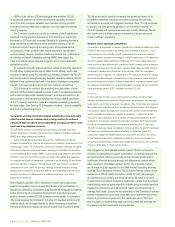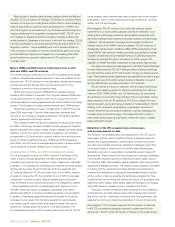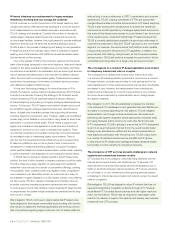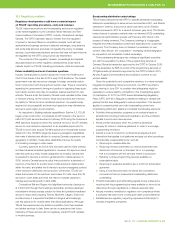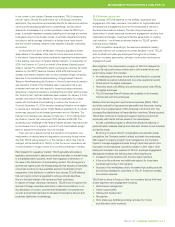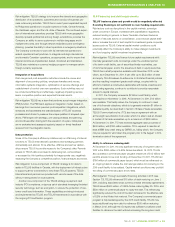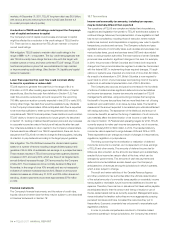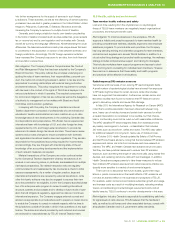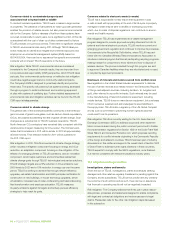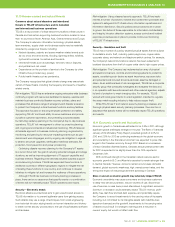Telus 2011 Annual Report Download - page 93
Download and view the complete annual report
Please find page 93 of the 2011 Telus annual report below. You can navigate through the pages in the report by either clicking on the pages listed below, or by using the keyword search tool below to find specific information within the annual report.
TELUS 2011 ANNUAL REPORT . 89
MANAGEMENT’S DISCUSSION & ANALYSIS: 10
10.3 Regulatory matters
Regulatory developments could have a material impact
on TELUS’ operating procedures, costs and revenues
TELUS’ telecommunications and broadcasting services are regulated
under federal legislation by the Canadian Radio-television and Tele-
communications Commission (CRTC), Industry Canada and Heritage
Canada. The CRTC has taken steps to forbear from the regulation
of prices for services offered in competitive markets, such as local
residential and business services in selected exchanges, long distance
and some data services, and does not regulate the pricing of wireless
services. Local telecommunications services that have not been forborne
are regulated by the CRTC using a price cap mechanism.
The outcome of the regulatory reviews, proceedings and appeals
discussed below and other regulatory developments could have a
material impact on TELUS’ operating procedures, costs and revenues.
Future availability and cost of wireless spectrum
Industry Canada plans to auction spectrum in both the 700 MHz and
2.5/2.6 GHz bands in the late 2012 to early 2013 timeframe. The federal
government may also announce changes to foreign ownership restric-
tions in conjunction with the spectrum auction rules. There is uncertainty
regarding the government’s timing and position in regulating these spec-
trum bands. Auction rules may, for example, reserve spectrum for new
entrants. There is a risk that Industry Canada could mandate further tower
or network sharing. As the rules for these future auctions are unknown,
the ability for TELUS to bid on additional spectrum, the capital outlay
required to bid successfully and how much spectrum may ultimately be
secured in each region are all uncertain.
As described in Building national capabilities in Section 2.2, TELUS
began urban construction of a wireless 4G LTE network in the second
half of 2011 with service launched in February 2012 using the Company’s
AWS spectrum acquired in 2008. Any potential roll-out of 4G LTE wireless
service to rural markets is dependent on an equitable opportunity for
TELUS to bid on and acquire 700 MHz spectrum in the planned auction.
Spectrum in the 700 MHz range has superior propagation capabilities
that make it effective and efficient in covering Canada’s expansive rural
geography. In addition, these same capabilities improve the quality
of in-building coverage in urban areas.
Currently, spectrum at 2.5/2.6 GHz has been used for fixed wireless
and fixed wireless broadcast applications. However, this spectrum band
has been given a primary mobile designation by Industry Canada and
is expected to become a common global band for mobile services. In
2006, Industry Canada issued a policy that provides for a clawback of
a portion of the band for auction when mobile service is implemented
within the band, and stated that it intends to auction unassigned portions
of the multipoint distribution service portion of the band. TELUS con-
siders that access to this spectrum would allow it to offer more 4G LTE
services in urban areas and meet the need to increase capacity to
manage exponential growth in data traffic.
Competitors Bell and Rogers hold significant amounts of spectrum
at 2.5/2.6 GHz through their Inukshuk partnership, and have deployed
a broadband wireless access solution for fixed and portable broadband
service in major cities including Toronto, Montreal, Calgary, Edmonton
and Vancouver. It is expected that Bell and Rogers will increasingly
use this spectrum for mobile rather than fixed applications. Although
TELUS has experienced only limited competition from fixed wireless
and similar services to date, there can be no assurance that future
marketing of these services will not negatively impact TELUS’ wireless
or wireline services.
Broadcasting distribution undertakings
TELUS holds licences from the CRTC to operate terrestrial broadcasting
distribution undertakings to serve various communities in B.C. and Alberta
(renewed in 2009 for a second full seven-year term), and in Eastern
Quebec (renewed in 2011 for a second full seven-year term). TELUS
also
holds a licence to operate a national video-on-demand (VOD) undertaking
(received an administrative renewal until February 2012 and is in the
process of being renewed). The Company’s strategy is to aggregate,
integrate and make accessible content and applications for customers’
enjoyment. The Company does not believe it is necessary to own
content. (See Section 10.1 Competition – Increasing vertical integration
by competitors into broadcast content ownership.)
The broadcasting landscape has undergone significant consolida-
tion with the acquisition by Shaw of the programming services of
Canwest Global (a transaction approved by the CRTC in October 2010)
and the acquisition by BCE of control of the programming services of
CTVglobemedia (a transaction approved by the CRTC in March 2011).
As well, Rogers Communications and Quebecor continue to own
content assets.
Given the potential for anti-competitive behaviour in a more vertically
integrated broadcasting market environment, the CRTC launched a
policy hearing in June 2011 to consider what safeguards might be
necessary to ensure healthy competition in the broadcasting sector.
On September 21, 2011, the CRTC issued Broadcasting Regulatory
Policy CRTC 2011-601 (Regulatory framework relating to vertical inte-
gration) that set clear safeguards to ensure competition. The decision
applies to companies that own both broadcasting content and
broadcasting distribution assets and includes the following elements:
.Prohibits offering television programs on an exclusive basis on
all platforms including mobile and broadband, and the prohibition
applies to sports and news services
.Allows content exclusivity when the content is developed
uniquely for online or mobile applications, in order to encourage
programming innovation
.Adopts a code of conduct for commercial arrangements and
interactions that applies to all platforms and sets out what constitutes
commercially unreasonable terms, such as:
.Requiring an unreasonable rate
.Requiring minimum penetration or revenue levels that force
distribution of a service on the basic tier or in a package
that is inconsistent with the service’s theme or price point
.Refusing to make programming services available on
a standalone basis
.Requiring an excessive activation fee or minimum subscription
guarantee
.Using a most favoured nation to extract anti-competitive
concessions from an independent broadcasting distribution
undertaking
.Prohibits head starts and withholding signals during a dispute by
requiring that the programming be made available on terms to be
determined through negotiations or dispute resolution later
.Adopts monetary remedies for regulatory non-compliance where
a company has been found to have given itself undue preference
.Establishes new regulatory reporting requirements that apply to
vertically integrated companies.


